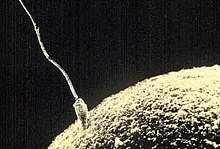Fertilization


Fertilization (British English spelling: fertilisation) is when a male's sperm enters a female's ovum (or "egg"). Fertilization is also called conception. Biologists call a fertilized egg a zygote. A zygote grows into an embryo.
Fertilization occurs in animals, including humans and birds, in plants, fungi, protists, in fact all eukaryotes. Fertilization makes a cell with twice as many chromosomes. The eukaryote life cycle includes meiosis which divides the chromosome number in half.
In animals[change | change source]
In animals, there are two types of fertilization, internal and external. Internal fertilization happens in the female body. External fertilization happens outside of the body. Mammals, birds, and reptiles use internal fertilization.[1] Amphibians and most fish use external fertilization. Some animals with internal fertilization give birth to live offspring. Others such as birds, most reptiles, and some mammals such as the Platypus, lay eggs.
Internal fertilization happens during mating (sexual intercourse in humans). Sperm cells travel from the male testicles to the female uterus. One sperm attaches to the egg in the uterus. Together, they become a zygote.
-
Most fish fertilize their eggs externally. The eggs and sperm are put into the water at the same time. (Here the sperm are not visible.)
-
Bird eggs are usually fertilized before they are laid. (In some birds and reptiles an unfertilized egg can still be laid, but it will never hatch.)
Related pages[change | change source]
References[change | change source]
- ↑ Pradhan, Sarala; Bespalova, Ioulia (2019-07-16). "Internal Fertilization". askabiologist.asu.edu. Retrieved 2021-01-15.



